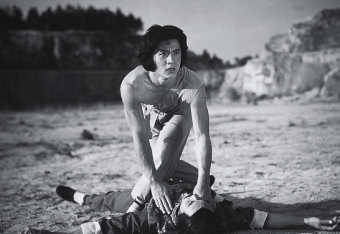Movies and Film: Hong Kong: Cantonese, Kung-Fu, and a New Wave
Hong Kong: Cantonese, Kung-Fu, and a New Wave
Despite its small size, Hong Kong has produced one of the most vibrant, lucrative, and internationally successful Asian cinema traditions during the past 40 years. While films from the mainland in the Mandarin dialect were dominant in the years following World War II, by the mid-'50s a solid majority of films produced in Hong Kong were made or at least subtitled in Cantonese, reflecting the more southern, working-class origins of the large emigrant population from the mainland.
Initially, Cantonese cinema focused primarily on social ills and problems faced by Hong Kong's urban laborers, and production quality was not high on the priority list. With the founding of the Zhonglian studio in 1952, however, directors such as Wu Hui (Family, 1953), Qin Jian (How to Get a Wife, 1961), and Li Chenfeng (Broken Spring Dreams, 1955; based on Tolstoy's Anna Karenina) worked to bring a modicum of artistic respectability to Cantonese cinema. Though most of this period's films were melodramas, derivative comedies, and opera adaptations, Hong Kong Cantonese flourished for more than a decade before giving way to a new, butt-kicking (literally) genre of Mandarin film that took Asian cinema by storm beginning in the late '60s.
Bodies in Motion: The Violent Art of Kung-Fu Films
The most familiar Hong Kong films to Western audiences are kung-fu and other martial arts movies. These violent visual vehicles burst onto the scene in the late '60s with Chang Cheh's One-Armed Swordsman (1967), which broke all previous box-office records for Hong Kong film. Combining quick-cut action sequences with an almost mystical reverence for eastern martial arts traditions, these films lit a fire under the city's somewhat moribund film industry and brought the first international recognition to Hong Kong cinema. In a sign of the genre's growing prestige, King Hu's A Touch of Zen won the Grand Prix at Cannes in 1975.
Director's Cut
One of the major factors in the success of the Hong Kong kung-fu film was the considerable martial arts talent of Bruce Lee. Born in San Francisco and long employed in Hollywood playing bit parts since the early '50s, Lee spent many years in Hong Kong and came to international prominence with The Big Boss (1971), directed by Luo Wei.
Unlike many stars of the martial arts genre, Lee was an actual expert in kung fu and karate, inspiring millions of fans to take up these arts themselves and launching a "karate craze" in the United States in the early '70s. After subsequent films like Fists of Fury (1971) and Way of the Dragon (1973), Lee became a household name in many parts of the world. His legend only grew after his early death in 1973 from a brain hemorrhage.
Indeed, perhaps the most significant aspect of the new genre's popularity was its effect upon Hong Kong cinema's relations with its international competitors. Unlike all of the European nations, as well as Japan, South Korea, and Taiwan, Hong Kong has the unique distinction among westernized nations of having established an indigenous cinema tradition that actually outsells Hollywood.
As you should know very well by now, this is no minor accomplishment in the world of feature film, which is so often dominated by American product.
Rolling with the Punches: Hong Kong's "New Wave"
Short Cuts
Throughout the '90s, Hong Kong-produced films maintained a market share above 50 percent—a considerable accomplishment considering the worldwide dominance of American film during the past 20 years.
Hong Kong's martial arts genre continued to attract some of the principality's best directing talents into the '80s and even '90s, decades that witnessed a "New Wave" of directors, writers, and actors emerge onto the world stage. John Woo's career was launched with The Young Dragons (1973) and The Dragon Tamers (1974) before he went on to make his even more violent action thrillers Hard Boiled (1992) and, in the United States, the artful Hard Target (1993), Broken Arrow (1996), and Face/Off (1996).
Some of Hong Kong's most popular actors during the past 10 years also got their start in martial arts films: Chow Yun-fat starred in several Woo pictures before breaking into the Hollywood mainstream. Jackie Chan became one of the most important and influential actor-directors to emerge from the Far East in the past 30 years with his unique blend of slapstick comedy and traditional martial arts wizardry (Half a Loaf of Kung-Fu, 1978).

Jackie Chan kicking his career into high gear in Snake in the Eagle's Shadow (1978).

Excerpted from The Complete Idiot's Guide to Movies and Film © 2001 by Mark Winokur and Bruce Holsinger. All rights reserved including the right of reproduction in whole or in part in any form. Used by arrangement with Alpha Books, a member of Penguin Group (USA) Inc.
To order the e-book book direct from the publisher, visit the Penguin USA website. You can also purchase this book at Amazon.com.
